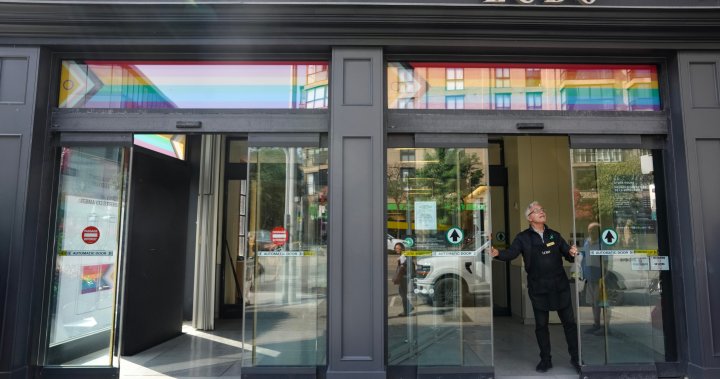Part of Ottawa’s response to the threats of tariffs by U.S. President Donald Trump so far has been to vow to work on easing interprovincial trade barriers.
Some experts say one sector where consumers often feel the effects of those barriers is the sale and purchase of alcohol across provincial lines.
“It’s easier to get a bottle of wine from Chile than it is (to get one) from British Columbia,” said Matthew Holmes, executive vice-president and chief of public policy at the Canadian Chamber of Commerce.
He added that even in provinces like Alberta, where private sellers of alcohol are prominent, the province still controls the alcohol that comes in and how it’s purchased.
“Mr. Trump is reminding Canadians of how dysfunctional our confederation is economically,” Sylvain Charlebois, director of the Agri-Food Analytics Lab at Dalhousie University, said.
Charlebois said this makes Canadian winemakers and brewers overly reliant on the U.S.
“Nova Scotia, Ontario and B.C. — all three provinces do produce a lot of wine. But they’re reliant on the U.S. to generate more income. It’s more difficult to sell to other provinces than it is to sell to U.S., which is not normal.”
While interprovincial trade barriers exist across the country, Charlebois said Quebec and Ontario have “by far” the most restrictive policies when it comes to importing alcohol from out-of-province.
“Both provinces have not been open to any discussions to open up their markets,” he said.

In Quebec, only the provincial alcohol corporation Société des alcools du Québec (SAQ) has legal authority to import alcohol into the province. Quebecers bringing alcohol into the province are required to contact the SAQ via an online form, even if it is a gift, donation, inheritance or souvenir from a trip.
The regulations can often prevent small business owners like Matt Tweedy from scaling up. Tweedy is the co-founder of the Tooth and Nail Brewing Company based in Ottawa’s Hintonburg neighbourhood, a stone’s throw from the provincial boundary between Ontario and Quebec.

Get breaking National news
For news impacting Canada and around the world, sign up for breaking news alerts delivered directly to you when they happen.
Quebec’s provincial regulations mean he can’t sell his beer across the Ottawa River.
“We ran into a situation a few years ago where a friend was getting married on the Quebec side of a particular structure that straddles Ontario and Quebec. We couldn’t sell beer to his wedding. They weren’t aware that this was the law when they booked the location,” he said.
Until 2019, Ontario had strict limits on how much alcohol you could bring into the province. The previous limit was nine litres of wine, three litres of spirits and 24.6 litres of beer. While that limit was lifted in October 2019, it only extended to alcohol use for personal consumption.
If Ontarians want to order liquor not for sale in the province, they have to place their order through the Liquor Control Board of Ontario (LCBO). Direct shipment of alcohol from other provinces to consumers is not allowed.
In addition to being a source of revenue, regulations also help provinces protect local industries from competition.
“In Ontario, they have a vast wine industry and protectionism seem to have been a priority,” Charlebois said, “When you have 16 million people, sometimes you feel content to service that market. But when you’re a province of a million people of four or five million people, you’re thirsty for more.”

Some provinces, however, are changing course.
Starting this month, wineries in B.C. can now directly ship wine to consumers in Alberta, the result of an interprovincial deal that was agreed to last year. The process allows Albertans to order wine from more than 300 B.C. wineries in exchange for the Alberta government getting its share of applicable taxes.
The agreement will run for one-year and will be evaluated.
Premier David Eby says in a statement that the new direct-to-consumer program is “a win” for wineries and for communities that rely on the industry.
“By working collaboratively with Alberta, we’re supporting economic growth and strengthening ties between our provinces,” Eby said in a press release.
According to Wine Growers British Columbia, the B.C. wine industry generates approximately $3.75 billion annually, contributes over $440 million in federal and provincial tax revenues, and employs over 14,000 full-time workers.
“Wine Growers BC has long advocated for interprovincial free trade across Canada, with a particular focus on Alberta due to the province’s proximity and the long-standing relationship between the two provinces,” the group said in a statement earlier this month.
Beer is difficult to transport across provincial lines too.
In 2012, New Brunswick resident Gérard Comeau travelled to Quebec to buy cheap beer. He was fined nearly $300 for possessing liquor not purchased from the New Brunswick Liquor Corporation.
When he contested the ticket, his case ended up before the Supreme Court, in what came to be known as the ‘Free the Beer’ case. The Supreme Court came down on the side of provinces being allowed to regulate the liquor trade, allowing New Brunswick to maintain its provincial monopoly.

However, Charlebois said provinces can take some lessons from the 2018 verdict.
“The Supreme Court basically said in its ruling, it’s up to the provinces to do its work to open up the market a little bit more,” he said.
Tweedy said easing barriers could help businesses like his to scale up.
“If we were able to open up these markets and take down the provincial barriers, perhaps we could get our businesses up to the economies of scale that could compete with some of these international brands,” he said.
Holmes said Canada could greatly benefit by easing trade between provinces.
“There’s work you can do at home to actually make Canadians have a stronger economy at home, so we’re not as reliant and exposed to the U.S. market,” he said.
— with files from Global’s Touria Izri





